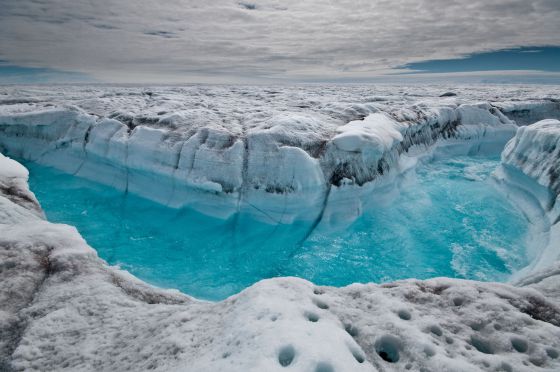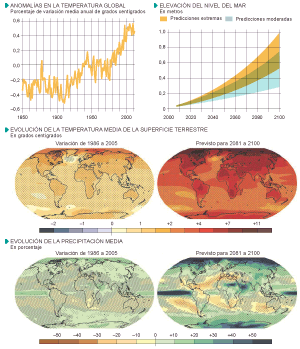
A landmark report says scientists are 95% certain that humans are the "dominant cause" of global warming since the 1950s.The report by the UN's climate panel details the physical evidence behind climate change. On the ground, in the air, in the oceans, global warming is "unequivocal", it explained. It adds that a pause in warming over the past 15 years is too short to reflect long-term trends. The panel warns that continued emissions of greenhouse gases will cause further warming and changes in all aspects of the climate system. To contain these changes will require "substantial and sustained reductions of greenhouse gas emissions". After a week of intense negotiations in the Swedish capital, the summary for policymakers on the physical science of global warming has finally been released.
The first part of an IPCC trilogy, due over the next 12 months, this dense, 36-page document is considered the most comprehensive statement on our understanding of the mechanics of a warming planet.
It states baldly that, since the 1950s, many of the observed changes in the climate system are "unprecedented over decades to millennia". Each of the last three decades has been successively warmer at the Earth's surface, and warmer than any period since 1850, and probably warmer than any time in the past 1,400 years. "Our assessment of the science finds that the atmosphere and ocean have warmed, the amount of snow and ice has diminished, the global mean sea level has risen and that concentrations of greenhouse gases have increased," said Qin Dahe, co-chair of IPCC working group one, who produced the report. Since 1950, the report's authors say, humanity is clearly responsible for more than half of the observed increase in temperatures.
In the summary for policymakers, the scientists say that sea level rise will proceed at a faster rate than we have experienced over the past 40 years. Waters are expected to rise, the document says, by between 26cm (at the low end) and 82cm (at the high end), depending on the greenhouse emissions path this century.
The scientists say ocean warming dominates the increase in energy stored in the climate system, accounting for 90% of energy accumulated between 1971 and 2010. For the future, the report states that warming is projected to continue under all scenarios. Model simulations indicate that global surface temperature change by the end of the 21st Century is likely to exceed 1.5 degrees Celsius, relative to 1850.
Prof Sir Brian Hoskins, from Imperial College London, stated: "We are performing a very dangerous experiment with our planet, and I don't want my grandchildren to suffer the consequences of that experiment."
It is "virtually certain" that the upper 700m of the Earth's oceans have warmed during the period from 1971 and 2010. The deep ocean, below 3,000m in depth, "likely" warmed between 1992 and 2005, says the report, with the largest effect observed in the Southern Ocean. The report says that the Greenland and Antarctic ice sheets have been losing mass, glaciers have continued to shrink, and Arctic sea-ice as well as Northern Hemisphere spring snow cover have continued to fall in extent. Sea level rise will proceed more quickly than it has done over the past 40 years. Waters are expected to rise, the document says, by between 26cm (at the low end) and 82cm (at the high end), depending on greenhouse emissions this century.
One of the key findings in the IPCC report is the attribution of more than half the increase in global surface temperatures from 1951-2010 to human activities, underlining the dominant role of fossil fuel burning as a driver for climate change. The atmospheric concentration of the greenhouse gas carbon dioxide (CO2) has increased by 40% since pre-industrial times. And the mean rates of rise in concentrations of CO2, methane (CH4) and nitrous oxide (N20) in the last 100 years are "with very high confidence" unprecedented in the last 22,000 years, the authors say.
A favourite of climate "sceptics", the Medieval Warm Period, is also referenced in the report. In some places this period, from 950-1250 AD, was comparable in its warming with the late 20th Century, but the report says this did not occur as coherently across seasons and regions as the current phase of warming
Climate sceptics have previously targeted the reliability of future projections based on computer simulations, or climate models. But those who work with such models will often cite the phrase: "All models are wrong, but some are useful". The IPCC says these simulations are indeed useful, faithfully reproducing long-term temperature trends, the rapid global warming in the second part of the 20th Century and the cooling observed following large volcanic eruptions.
But there remain inconsistencies between observed changes in the climate system and the conditions simulated by computers. An obvious one is the slowdown in warming since 1998. The report says this could be due to unpredictable variability in the climate and over-sensitive responses to greenhouse gases in some climate models.
The report adds that there has been improvement in the way these models simulate changes in continental rainfall patterns, but regional-scale rainfall is not well reproduced. It is "virtually certain" that most places will see more hot and fewer cold temperature extremes as temperatures rise. And it is very likely that heat waves will occur more frequently, though occasional winter extremes will continue to occur. Limiting the global average temperature rise to 2C (above the pre-industrial average) is a commonly agreed means of avoiding "dangerous climate change". But a significant amount of the maximum quantity of CO2 that can be emitted while still keeping the mercury under 2C had already been released by 2011.
Some 15%-40% of released CO2 will remain in the atmosphere longer than 1,000 years after those emissions have ended, raising the prospect that some fraction of climate change will be irreversible. It is "virtually certain" that sea level rise will continue beyond 2100 and sustained warming above some unknown threshold would lead the Greenland Ice Sheet to melt in a millennium or more, causing a global mean sea level rise of up to 7m.

So how will all this affect Spain?
Glaciers in eight of the nine European glacial regions are retreating. Pyrenean glacial retreat has been most notable (8). The Pyrenees have lost almost 90% of their glacier ice in the previous century and the rest may disappear within a few decades. The melting rate of the ice that is still there keeps increasing: between 2002 and 2008 the Spanish Pyrenees lost about a quarter of their volume.
Temperatures in the Catalan Sea have increased around 1.1°C in the uppermost waters (0 to 50m) and around 0.7°C at 80 m over the last 35 yr (from 1974 to 2008) (16), which is a similar rate to that inferred from satellite observations between 1985 and 2006 for the western Mediterranean (0.03°C per year (17)). The change in temperature in the northwestern Mediterranean Sea in the last decades seems to be more pronounced than the temperature increase in the oceans on a global scale. A recent compilation of temperature time series from the western Mediterranean Sea reveals a consistent warming pattern over the last 40 yr at a very similar increasing rate.
The EEA currently predicts a rise in average temperature in Spain of around 4 degrees by 2080. Extreme summers like the 2003 spell are likely to become four times as common in Spain and southern Europe. Under high emission scenarios every second summer in Europe will be as hot or even hotter than 2003 by the end of the twenty-first century. In southern Europe, these changes are projected to occur even earlier (in Spain by the 2020s). The report by the EEA puts the expected rise in temperature in Europe at between 2 and 6.3 degrees by 2100.
Temperatures in Spain are forecast to rise steadily by 0.4ºC a decade in winter, and by 0,6-0.7ºC in summer. By 2100 temperatures in the hinterland of the Peninsula would be 5-7⁰C higher in summer and 3-4ºC in winter. Temperatures on the coast would rise by some 2ºC less than the hinterland. The number of days with extreme high temperatures would rise.
The projected temperature rise at the end of the 21st century differs by 3⁰C for low and high greenhouse gasses emissions scenarios. Generally, the rise in temperature is expected to accelerate at the end of the 21st century. Temperature rise is expected to be comparable for all regions in the winter, more in central and southern regions in spring, and more in the interior than along the coast in summer and autumn. Maximum temperatures are expected to rise more than average and minimum temperatures.
For the Basque Country, model studies showed a 50% decrease in the number of frost days (Tmin < 0°C) at the end of the century. Cold-wave episodes, defined as 6 consecutive days having temperatures lower than the seasonal temperature during 1978– 2000 by 5°C, are expected to disappear beyond 2020. The number of heat waves (6 consecutive days having temperatures higher than the seasonal temperature during 1978– 2000 by 5°C), is projected to increase from the current 12% of summer days to 16% in 2050 and 22% by the end of the century.
Generally, precipitation is projected to decrease all over Spain, and this decrease is expected to accelerate at the end of the 21st century. With respect to the present situation the annual precipitation is projected to decrease by 5% in the central, northern and eastern regions, and by 10% in the southwest in 2011-2040. In 2070-2100 the projected decrease is 15 (low emissions scenario) - 25% (high emissions scenario) in the central and northern regions, and 20 (low emissions scenario) - >30% (high emissions scenario) in the south.
For specific regions and specific seasons, different estimates have been reported, however. For Andalucía and the upland parts of Cataluña climate model calculations suggest a significant annual precipitation reduction of between 6 to 14% at the end of the 21st century (compared with 1971-1990). In contrast, an increase is calculated in annual totals of up to 14% along parts of the coast between Almería and the French border. Projections suggest that in the already wet northeast rainfall might increase in winter.
The Pyrenees are likely to experience milder winters with more precipitation, and hotter, drier summers. These conditions are likely to reduce snow cover on the mountains since, in most temperate mountain regions, the snow temperature is close to the melting point and therefore very sensitive to changes in temperature.
For the Iberian Peninsula there is no consensus on the changes in extreme precipitation for 2070–2100. Results of different climate models suggest that extreme precipitation over the Basque Country may be expected to increase by around 10% throughout the 21st century.
Climate change projections for the end of this century (2071–2100) show an increase in the mean length of dry spells and in the largest dry spells related to a 2-year return period.
According to model calculations no significant change in wind climate is projected for the 21st century.
Are we doing enough to change this? And what if we are wrong and the affects will be even more drastic than thought. With the world as it is now how will they agree on terms to save the planet, which we are obviously killing everyday that goes by. There is a Spanish expression which says “pan para hoy, hambre para mañana” ythis is what is happening, the need to generate as much money as possible now while ignoring the consequences of tomorrow…
(sources: BBC news / IPCC / EEA)